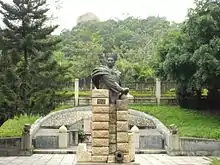Chen Huacheng
Chen Huancheng (1776–1842) was a 19th-century military leader of Qing China.[1] He served as the provincial military leader in Jiangnan Province before being killed in the First Opium War.[2]
Chen Huacheng | |
|---|---|
 Chen Huacheng's tomb. | |
| Born | 1776 |
| Died | June 16, 1842 (aged 65–66) |
Biography
Chen joined the Imperial Army at a young age, in which he served as a standard bearer. Unlike some of his contemporaries, he rose from the ranks of the army to a command position without taking the customary Wu Keju Imperial Examinations.[1] His early promotions were due to his success in suppressing piracy.[2]
In 1830 Chen was promoted to Admiral of Fujian Province by the Daoguang Emperor. During this time he was stationed in Xiamen. He was promoted again in 1840 when he became a Jiangnan Admiral, the highest rank in the Imperial Navy.[2]
During the First Opium War Chen commanded the Chinese defenses at the mouth of the Yangtze River.[2] He swore to defend the waterway and began to fortify his position against British incursions. On 16 June 1842 a British fleet sailed up the Yangtze and began to bombard Huacheng's position at Wusong.[3] While commanding the Chinese fort there, Chen was killed by either naval artillery or in hand-to-hand combat with the British.[4]
References
- Haijian, Mao (2016-10-18). The Qing Empire and the Opium War. Cambridge University Press. ISBN 9781107069879.
- National Palace Museum Library and Literature Department Qing Dynasty History Museum package, 702003435-5 number
- Rait, Robert S. (1903). The Life and Campaigns of Hugh, First Viscount Gough, Field-Marshal. Volume 1. Westminster: Archibald Constable.
- NA, NA (2016-04-30). Japan and China: Mutual Representations in the Modern Era. Springer. ISBN 9781137083654.
- "China Institute Study Tour 2011 - China & Taiwan in the 21st Century". www.mitchellteachers.org. Retrieved 2017-06-23.